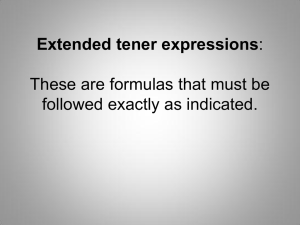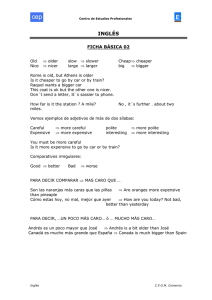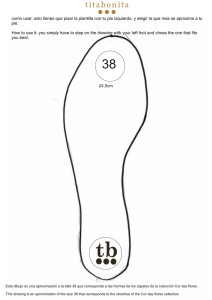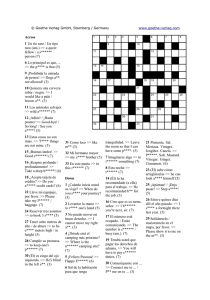Print this article - Revistes Digitals de la UAB
Anuncio
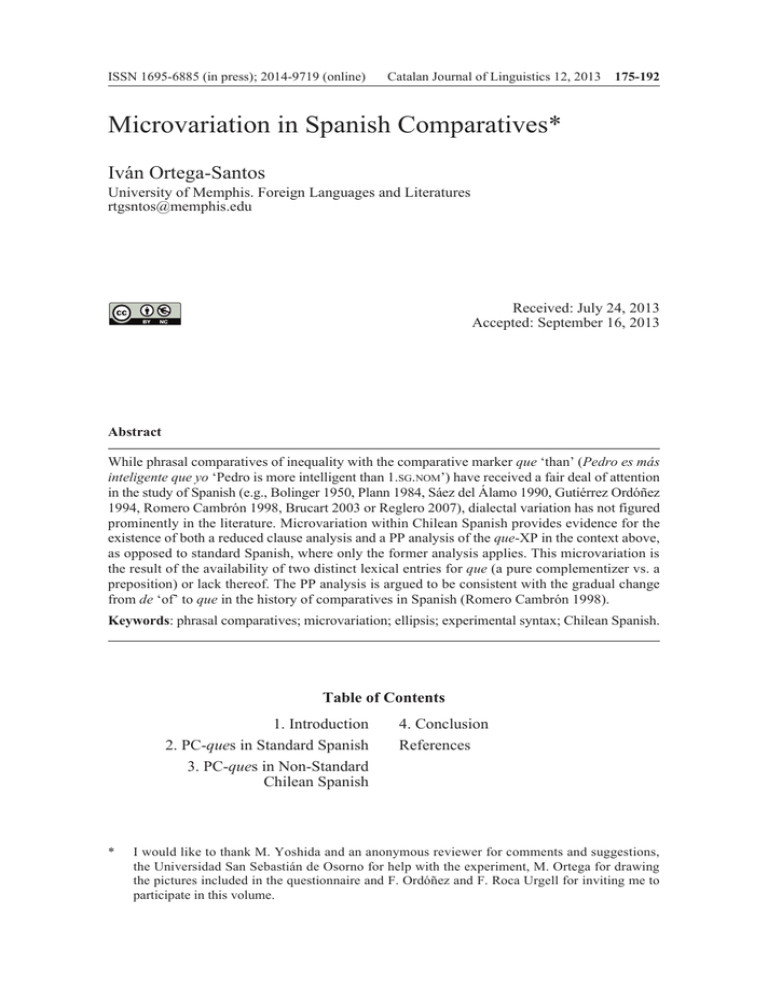
ISSN 1695-6885 (in press); 2014-9719 (online) Catalan Journal of Linguistics 12, 2013 175-192 Microvariation in Spanish Comparatives* Iván Ortega-Santos University of Memphis. Foreign Languages and Literatures rtgsntos@memphis.edu Received: July 24, 2013 Accepted: September 16, 2013 Abstract While phrasal comparatives of inequality with the comparative marker que ‘than’ (Pedro es más inteligente que yo ‘Pedro is more intelligent than 1.sg.nom’) have received a fair deal of attention in the study of Spanish (e.g., Bolinger 1950, Plann 1984, Sáez del Álamo 1990, Gutiérrez Ordóñez 1994, Romero Cambrón 1998, Brucart 2003 or Reglero 2007), dialectal variation has not figured prominently in the literature. Microvariation within Chilean Spanish provides evidence for the existence of both a reduced clause analysis and a PP analysis of the que-XP in the context above, as opposed to standard Spanish, where only the former analysis applies. This microvariation is the result of the availability of two distinct lexical entries for que (a pure complementizer vs. a preposition) or lack thereof. The PP analysis is argued to be consistent with the gradual change from de ‘of’ to que in the history of comparatives in Spanish (Romero Cambrón 1998). Keywords: phrasal comparatives; microvariation; ellipsis; experimental syntax; Chilean Spanish. Table of Contents 1. Introduction 2. PC-ques in Standard Spanish 3. PC-ques in Non-Standard Chilean Spanish * 4. Conclusion References I would like to thank M. Yoshida and an anonymous reviewer for comments and suggestions, the Universidad San Sebastián de Osorno for help with the experiment, M. Ortega for drawing the pictures included in the questionnaire and F. Ordóñez and F. Roca Urgell for inviting me to participate in this volume. 176 CatJL 12, 2013 Iván Ortega-Santos 1. Introduction While comparative constructions have received a fair deal of attention in the study of Spanish and beyond (e.g., see the synchronic analyses in Piera 1983, Gutiérrez Ordóñez 1994, Plann 1984, Sáez del Álamo 1990, Brucart 2003, Reglero 2007, a.o., and the diachronic analysis in Romero Cambrón 1998, a.o., for Spanish), dialectal variation has not figured prominently in the literature (though see Bolinger 1950 for a notable exception). The purpose of this research is to fill this gap in our knowledge while contributing to our understanding of these constructions. Specifically, this research focuses on microvariation for a subcase of comparative structures illustrated in (1), namely, phrasal comparatives of inequality which make use of the comparative marker que ‘than’ (PC-que): (1) Pedro es más inteligenteque yo. Pedro is moreintelligent than1.sg.nom ‘Pedro is more intelligent than me.’ Other subcases of phrasal comparatives, structures where the comparative marker is followed by a single phrase, will not be discussed, as these have been established to have different syntactic properties (see Sáez del Álamo 1999 and Brucart 2003 for discussion, a.o.). E.g., I abstract away from phrasal comparatives introduced by the preposition de ‘of’ taking a measurement phrase as the compared NP, (2a),1 or pseudo-comparatives, structures that resemble comparatives in their form but not in their meaning, e.g., (2b): (2) a. Tiene más de 500 euros. has more than 500 euros ‘He/she has more than 500 euros.’ b. Leyómás libros que El camino. read morebooks thanEl camino ‘He/she read some books on top of El camino.’ Furthermore, a comprehensive literature review, even when limited to Spanish, is beyond the scope of this article and, therefore, I focus on those proposals that will be most relevant for the discussion.2 Specifically, there is an ongoing debate on the following two aspects of the syntax of PC-que: (i.) whether the que/than-XP has full-fledged clausal syntax underlyingly as opposed to being base-generated; (ii.) the syntactic category of que/than (a complementizer introducing a reduced clause, a coordinating conjunction or a preposition). Not all of these analyses are mutually exclusive. For instance, a number of authors have shown that comparatives with 1. For discussion on the distribution of de vs. que, see Bolinger (1950), Solé (1982), Plann (1984), Romero Cambrón (1997) or Brucart (2003), a.o. 2. For discussion on the semantics of comparatives, see Bresnan’s (1973) Comparative Deletion and Chomsky’s (1977) empty operator analysis. See also fn. 3 in this regard. Microvariation in Spanish Comparatives CatJL 12, 2013 177 one single phrase in the coda may divide themselves into clausal and prepositional comparatives in the same language, e.g., Napoli (1983), Hankamer (1973) or Bhatt and Takahashi (2011), a.o., whereas the view that a certain comparative marker (than) is a preposition or a coordinating conjunction is a priori compatible with both a clausal or a base-generation analysis. Still, the prepositional analysis of que/ than has traditionally been linked to the base-generation analysis or direct analysis, e.g., see Hankamer (1973), Hoeksema (1983) and Napoli (1983), a.o, whereas an understanding of the comparative marker as a complementizer has been linked to the reduced clause analysis for obvious reasons (see Bresnan 1973, Hankamer 1973 and Pinkham 1982, a.o.). The analyses of que as a preposition, a complementizer and a coordinating conjunction are illustrated in (3a,b,c), respectively:3 (3) a. Pedro es más inteligente [PP que María]. Pedro is moreintelligent than María b. Pedro es más inteligente [CP que Maríax [TP tx esinteligente]]. Pedro is moreintelligent than María isintelligent c.[TP Pedro es más inteligente] que [TP Maríax [TP tx es inteligente]]. With regard to Standard Spanish (SS), both a clausal and a prepositional analysis for PC-que have been put forward. Specifically, Gutiérrez Ordóñez (1994) and Brucart (2003) defend both a clausal and a prepositional analysis, though for slightly different syntactic contexts. Brucart (2003: 40) assumes a base-generation PP analysis for structures where the correlate of the compared NP, that is to say, the correlate of the complement of que, includes the comparative particle más, e.g. (4a), whose analysis is illustrated in (4a’).4 This contrasts with (4b), which for him should receive a clausal analysis, illustrated in (4b’): 3. I abstract away from irrelevant details; in (3c), where que is a coordinator, clausal ellipsis is also present, though, as stated, not every researcher that adopted this kind of analysis would agree, (e.g., cf. Sáez del Álamo 1999 and Lechner 2001). If phrasal comparatives have clausal syntax, one single unified semantic analysis would work for both reduced and unreduced comparatives (see Heim 1985 and Bhatt and Takahashi 2011 for discussion). Furthermore, under the plausible assumption that the comparative marker más/-er is a degree quantifier that takes the que/than-clause as an argument, the lack of adjacency between those two elements in certain examples has been explained as the result of extraposition of the latter element (Bresnan 1973 and Heim 2000, a.o.; see Kennedy 1999, a.o. for an alternative view). 4. A PP analysis has also been put forward for (i), under the second interpretation (Plann 1984, Sáez del Álamo 1990, a.o.): (i)MarianohatenidomejoresprofesoresqueSánchezy Rodríguez. Marianohashad better teachers than Sánchez andRodríguez Clausal interpretation: ‘Mariano has had better teachers than Sánchez and Rodríguez have had.’ PP-interpretation: ‘Mariano has had teachers who are better than Sánchez and Rodríguez.’ 178 CatJL 12, 2013 Iván Ortega-Santos (4) a.Comprómás revistas que libros. bought moremagazinesthanbooks ‘He/she bought more magazines tan books.’ a’.Compró [DegP [Spec Øi] [Deg’ [Deg’ más [QP ti [SN revistas] ] ] [PP que [QP Ø libros] ] ]] b.Comprómás revistas quetú. bought moremagazines thanyou ‘He/she bought more magazines than you.’ b’.Compró [DegP [Spec Øi] [Deg’ [Deg’ más [QP ti [SN revistas] ] ] [ForceP que [FocP [Spec Ø revistas] ] comprastev [TP túj tv [SV tj tv ti] ] ] ] ] In contrast, Gutiérrez Ordóñez (1994: 21) assumes a base-generation analysis only for cases where the comparative morpheme, e.g., más, modifies a noun or an adjective: (5) Unanovelamás divertidaque inspirada a novel morefun thaninspired ‘a novel that is more fun to read than well-written’ According to this researcher, the reduced clause analysis applies elsewhere. In turn, Sáez del Álamo (1992, 1999) argues for a base-generation analysis where que is a coordinator (see also Napoli and Nespor 1986, a.o.; see Brucart 2003 for a review of Sáez del Álamo’s proposal; see Lechner 2001 for an updated version of the coordination analysis where the extraposition of the than-XP establishes a comparative coordination which is obligatorily undone in the semantic component yielding the effect of semantic subordination). In contrast to these proposals, the current research links the availability of both the reduced clause and the prepositional analyses of PC-que to dialectal variation. Specifically, this paper discusses novel data from Chilean Spanish that suggest the coexistence of both the reduced clause analysis and the PP analysis in this variety, in contrast to SS where only the former analysis is found. Data were gathered by means of a grammaticality judgment task. Section 3 discusses the analysis of PC-que in SS, whereas section 4 focuses on Non-Standard Chilean Spanish (NSCSp). 2. PC-ques in Standard Spanish The goal of this section is to introduce the main features of PC-ques in SS. No attempt will be made to decide between the reduced clause analysis and the coordination analysis. The emphasis will be put on ruling out a base-generation prepositional analysis, an issue that will be relevant when analyzing microvariation in the structures under discussion. Microvariation in Spanish Comparatives CatJL 12, 2013 179 2.1. Some arguments against the base-generated PP analysis5 First, more than one remnant may survive ellipsis, as long as the remnants are focused, as seen in (6) where the two remnants clearly are not a constituent. In fact, unelided counterparts of PC-ques are attested as well, provided that the material in the que-XP does not constitute old information (e.g., Gutiérrez Ordóñez 1994: 25, among many others; see Reglero 2007 for detailed discussion; example taken from Price 1990), (7), an observation that applies as well to other ellipsis contexts, e.g., Sluicing (Merchant 2001, a.o.). (6) Pedroesinteligentey Maríaamable. Pedrois intelligent andMaríafriendly ‘Pedro is intelligent and María is friendly.’ (7) Mi padre vendemás libros que discos comprami madre. my father sells morebooksthanrecordsbuys mymother ‘My father sells more books than my mother buys records.’ This suggests that the PC-que construction is derivationally related to the full clause counterpart (see Lechner 2001 for recent discussion; see Hankamer 1973 or Napoli 1983 for divergent views on this issue). Similarly, the que-XP may host a temporal adverb different from the main clause, a fact that suggests that it has tense specification:6 (8) Hoy Jorgecomiómás que Pedroayer. todayJorge ate morethan Pedro yesterday ‘Today, Jorge ate more than Pedro did yesterday.’ The ellipsis remnant shows the connectivity effects typically seen in non-elliptical sentential environments. E.g., in (9) the correlate needs to bear a preposition consistent with the lexical entry of the verb as opposed to a dummy preposition such as de ‘of’, in keeping with the idea that it has originated from a full-fledged sentential structure (Merchant 2001, a.o.):7 5. Note that I am not committed to excluding a base-generation PP analysis in other subcases of phrasal comparatives such as (2) or the ones discussed by Gutiérrez Ordóñez (1994) and Brucart (2003) (see section 1). 6. As noted by an anonymous reviewer, the fact that no tense mismatches are tolerated, provides further evidence that the category affected by ellipsis is at least TP as opposed to vP or any smaller category (see Saab 2010: 92 for discussion on the size of ellipsis): (i) *Hoy Jorge comió más que Pedro mañana. todayJorgeate morethanPedrotomorrow ‘Today, Jorge ate more than Pedro will eat tomorrow.’ 7. See Pinkham (1982) for an LF-copying approach as opposed to an ellipsis or PF-deletion approach; see also Chung et al (1995) for a closely-related approach to prototypical ellipsis constructions such as Sluicing. 180 CatJL 12, 2013 Iván Ortega-Santos (9)Ayer se peleóconPedromásgentequecon /*de/*paraJuan. yesterday refl fought with Pedro morepeoplethatwith of for Juan ‘Yesterday more people fought with Pedro than with Juan.’ Furthermore, que can take a PP, that is to say, an element that does not need Case, as a complement, (9), in contrast to what the base-generation prepositional analysis of PC-que would predict. Additionally, unlike English, the Spanish comparative particle is homophonous with complementizer que, a fact that lends indirect support to the reduced clausal analysis. (10)Faustino dijo queNunciaesinteligente. Faustino saidthatNunciais intelligent ‘Faustino said that Nuncia is intelligent.’ While there are a number of different functions que can realize in the syntactic structure, its prepositional use is unattested – even if complementizers are known to have a close relation with prepositions (see Emonds 1985, van Riemsdijk 1978 and Kayne 2004; see also section 1 for discussion).8 Case morphology, which is overt in the pronominal system of the language, provides evidence against the prepositional analysis in phrasal comparatives.9 As expected, the Case of the remnant is determined by its function in the clause, (1), repeated here. (11)Pedroesmás inteligenteque yo / *mí / *me soyinteligente. Pedrois moreintelligent than 1sg.nom 1.sg.prep1.sg.accam intelligent While me is a clitic, a fact that introduces an interfering factor when accounting for the data in (11), that observation does not explain the ungrammaticality of the counterpart which includes the pronoun with prepositional phrase Case (PP-Case) mí. To sum up, a number of arguments in favor of the clausal ellipsis and/or the coordination analysis of PC-que have been put forward. This means that SS does not have prepositional comparatives, that is to say, truly phrasal comparatives, in the context under discussion.10 8. As noted in Section 1, the reduced clause analysis and the coordination analysis are not mutually exclusive. Furthermore, connectivity effects and other properties discussed in this section would also follow from a coordination analysis of comparatives. In fact, que seems to be used as a pseudo-coordination conjunction in expressions as (i) where the use of que as opposed to the coordinator y ‘and’ entails a certain amount of criticism: (i) Esta gente, todoel día come que /y come. these people all the day eats thatand eats ‘These people eat all day long.’ 9. Within the pronominal paradigm of Spanish only the 1st and 2nd person singular pronouns exhibit the Nominative vs PP-Case contrast at the phonetic level. Hence, I concentrate on those two forms throughout the discussion whenever Case properties are relevant. 10. For discussion of a number of arguments against an ellipsis approach to phrasal comparatives and some possible counterarguments, see Lechner (2001) and Merchant (2009). Microvariation in Spanish Comparatives CatJL 12, 2013 181 3. PC-ques in Non-Standard Chilean Spanish The goal of this section is to analyze PC-ques in NSCSp. Section 3.1 deals with the history of Spanish comparatives, which suggests the existence of prepositional que (Romero Cambrón 1998). Section 3.2 presents the methodology used to gather the data. Section 3.3 presents the results arguing that prepositional comparatives are available in this variety. Section 3.4 analyzes the differences between SS and NSCSp in the context of current proposals on microvariation. Section 3.5 presents issues for future research. 3.1. On the history of comparative structures in Spanish A first hint concerning the prepositional nature of que can be found in the history of Spanish. Specifically, Romero Cambrón (1998; her data) shows that the use of the preposition de in phrasal comparatives was increasingly replaced by que starting in the 15th century. In fact, the variation was so prevalent that in certain documents both options are found in the same sentence: (12)Qui esmas dulce quela miel oqual mas fuertedelleon? what is moresweetthanthehoney orwhichmorestrongthan-thelion ‘What is sweet than honey or which one is stronger than the lion?’ [Fazienda de Ultramar, 209] According to Romero Cambrón, the que version does not substitute the previous de version, but rather the data shows the continuity between both structures. That is to say, for Romero Cambrón, cases with que include a prepositional coda at least at a certain stage in development. In particular, she argues for the adoption of the comparative marker which was «more generic in the comparisons [que], maybe because of a process of analogy, at a time when de was increasingly felt to be the comparative particle specific to the «comparison of magnitudes», present in más de dos ‘more than two’, más de lo que debe, ‘more than he/she should’, más de lo debido ‘more than it is pertinent» (Romero Cambrón 1998: 87; my translation). Nonetheless, Romero Cambrón notes the paradoxical absence of prepositional Case on the complement of que when presenting the prepositional analysis of Sáez del Álamo (1990), an absence also noted by Piera (1983), Plann (1984), Price (1990) or Reglero (2007) when developing a synchronic analysis of SS (see also (11)). (13)mejor que tú / *ti betterthan 2.sg.nom 2.sg.prep ‘Better than you’ Standard Spanish In contrast, the data included in this research supports the prepositional analysis for NSCSp in that the ungrammatical pattern in SS in (13) is indeed attested in that variety. If true, that pattern is the intermediate link or state between the original 182 CatJL 12, 2013 Iván Ortega-Santos prepositional comparatives with de and the phrasal que-comparatives, namely, a prepositional que-XP. 3.2. Methodology Initial attempts to study NSCSp revealed the stigmatization of the structure, in that speakers who used it in naturalistic speech, consistently rejected the non-standard patterns in informal grammaticality judgment tasks. Furthermore, no cases were documented in newspapers or magazines and only relatively few cases were documented from other sources. E.g., the following examples were found in a movie, (14a), and on the internet using Google (www.google.com), (14b,c):11 (14)a. Yoactúo mejorque ti. I performbetterthan2.sg.prep ‘I am a better actor than you.’ [example from the Chilean film Mitómana] b. Tienesolo 9años y sabe peliar mas que ti. has only9yearsandknowsfight morethan2.sg.prep ‘He is 9 years old and he knows how to fight better than you.’ [Video title on the web www.quechimba.com] c. Por quellorar x ti mientras hay 1.000 personas mas why cry for2.sg.prepwhile there are1.000 persons more que ti enestemundo than2.sg.prepin this world ‘Why should one cry for you if there are 1.000 people other than you in this world?’ [Facebook community] 11. The national origin of the web contents could not be verified. It is hypothesized that the usage of PP-Case is found in other countries. E.g., the following example was documented by the author in naturalistic speech of Honduras: (i) Conocieronmás que mí. visited more than 2.sg.prep ‘You visited more places than I did.’ A search in the Corpus diacrónico del español (CORDE) revealed the productive use of PP-Case in PC-ques in the Biblia de Ferrara (1553), (ii.), whereas a search in the Corpus de referencia del español actual (CREA) returned one single case, (iii.): (ii) ... siete gentes, muchasy fuertes mas que ti seven people many and strong more than 2.sg.prep [Párrafo 5, Anónimo, Biblia de Ferrara, Moshe Lazar, Laberinthos, Culver City 1992] (iii)Meencontrécon unhombremuchomayorque mí. me foundwith a manmuch older than 1.sg.prep ‘I found myself with a man who was much older than me.’ [Párrafo 2, Hablando con Gemma, Telemadrid, 20/11/96 Spain] Microvariation in Spanish Comparatives CatJL 12, 2013 183 As a result a large scale questionnaire was developed to be able to elicit judgments from a larger population in a less time-consuming and more effective manner. In particular, a grammaticality judgment task was designed in order to gather negative data that an observational study or a corpus study could not provide. 30 students (29 females and 1 male) from the Universidad San Sebastián de Osorno participated voluntarily in a grammaticality judgment task which included the most important data points in order to analyze the comparative structures of both SS and NSCSp.12 The questionnaire consisted of an indirect grammaticality judgment task combined with a scale followed by a sentence completion task. With regard to the indirect grammaticality judgment task, it was indirect in the sense that instead of asking subjects whether a specific sentence was good in their dialect, a methodology that can lead speakers to use the most prestigious forms as opposed to the more representative ones (see Labov 1972), speakers were asked whether they could encounter the sentence in their dialect, be it in their own speech or in the speech of their friends and relatives (see Barbiers and Cornips 2000 and papers in that volume). This task was combined with a scale. Specifically, speakers could choose between three options (yes / I am not sure / no).13 Sentences included, for instance, both the standard and the non-standard pattern: (15)a. Pedroes más inteligenteque yo. Pedrois moreintelligent than1.sg.nom b. Pedroesmás inteligenteque mí. Pedrois moreintelligent than1.sg.prep Additionally, a sentence completion task was included. Specifically, certain properties of the subject were compared to another person so that the subject would have to use a pronoun, e.g., either yo or mí in (16), when completing the sentences: 12. The questionnaire was administered in a classroom setting, so it was not possible to exclude the male participant. Given that the questionnaire was not intended to unveil the link between certain linguistic usages and social variables, this sample was considered adequate for our research goals. 13. While the use of an indirect grammaticality judgment task is well-justified given the object of research, such tasks conflate to a certain degree the notion of acceptability with the notion of familiarity. In particular, if a speaker is unfamiliar with a specific syntactic variant, that variant is absent from his/her grammar and it is, therefore, ungrammatical. The reverse is not necessarily true: the fact that a given speaker is familiar with a certain form, might not necessarily mean that this form is part of his/her grammar. This, in principle, could pose a problem when interpreting the results. However, the sistematicity in the data concerning the predictions of the syntactic analysis can be taken as an indication that speakers did not only make use of the notion of familiarity, but indeed, acceptability. I thank M. Yoshida for discussion of this issue. Furthermore, since the purpose of the questionnaire was to gather syntactic data a small scale was used in contrast to a 5-point Likert scale frequently used in psycholinguistic research. 184 CatJL 12, 2013 Iván Ortega-Santos (16)Sentence completion task UstedLuisa You Luisa Question: ¿Quiénesmás pequeñode who is moresmall ‘Who is smaller?’ los dos? out-of thetwo Answer: Luisa es más pequeña que _____________ Luisa is moresmall than ‘Luisa is smaller than _____________.’ The sentence completion task was included to further observe the linguistic behavior of the subjects when given the opportunity to use the language as opposed to only evaluating sentences. Furthermore, it is a task that closely resembles an exam format – even more so than the grammaticality judgment task. As a consequence, speakers were expected to perceive it as a rather formal situation. Thus, the sentence completion task was expected to provide evidence for any link between the grammatical usage of PC-que and the choice style. 3.3. Prepositional Case on the complement of que 30 subjects rated examples of PC-ques including 1st person and 2nd person singular pronouns bearing either Nominative or PP-Case. The standard pattern clearly was judged grammatical (Mean = 3.0 (SD = 0)) in contrast to the PP-Case pattern (Mean = 1.45 (SD = 0.851). Still, a number of speakers judged the PP-Case pattern as grammatical and it is the grammar of these speakers that I will be analyzing. The following table includes the percentage of speakers who accepted PC-ques with a Nominative and a PP-Case pronoun, respectively, be it a 1st person or 2nd person singular pronoun. (17) Table 1. Percentage of speakers who accepted Nominative Case or PP-Case on the pronominal remnant in the PC-que construction Case of the remnant % Nominative Case 100 PP-Case 33.3 CatJL 12, 2013 185 Microvariation in Spanish Comparatives As can be seen, while all speakers accepted the standard pattern in (18), 1/3rd of the subjects also accepted PC-ques with PP-Case on the pronominal remnant, (19) (the number of speakers who accepted each example out of the 30 subjects is included throughout): (18)Pedro es más inteligente que yo. Pedrois moreintelligent than1.sg.nom ‘Pedro is more intelligent than me.’ 30/30 (19)Pedroes más inteligenteque mí. Pedrois moreintelligent than1.sg.prep 9/3014 Therefore, the questionnaire succeeded in documenting the availability of prepositional comparatives in the community even in such homogeneous sample, as suggested by the history of Spanish. Crosslinguistic variation provides further support for the availability of the prepositional analysis (see section 2.1). E.g., in English, evidence for the prepositional nature of than comes from the fact that it can be stranded in phrasal comparatives, just like a preposition (Hankamer 1973), (20), and from the Case properties of the complement of than, which shows PP-Case, (21): (20)a. Whox are you taller than tx? Comparative P-Stranding b.Whatx did you look at tx? (21)a. Peter is more intelligent than me. Comparative b. She bought this for me. PP-Case A number of data points relevant to the exact analysis of NSCSp were included in the questionnaire. Specifically, the prepositional Case analysis in English has been called into question, among other reasons, because the Case morphology of the pronoun can be found in other contexts, e.g., in coordinate structures, hanging topic constructions, or Gapping. This state of affairs suggests an analysis in terms of Default Case (see Lechner 2001 and Schütze 2001, a.o.): (22)a. Peter and me ... Coordination b. Me, I would .... Hanging Topic c. John is eager to meet them, and me too. Gapping [Lechner (2001: 728)]15 14. The 1st person singular pronoun was the first case of PP-Case found in the questionnaire. The fact that the very first example of NSCSp had such a high acceptance rate provides evidence that this result is not a task effect, e.g., a habituation effect whereby acceptability scores increase after repeated exposure to a structure. 15. In the unelided counterpart of Gapping, the subject receives Nominative Case, in contrast to the ellipsis structure (Lechner 2001: 728): (i) John is eager to meet them and I / *me am eager to meet them, too. 186 CatJL 12, 2013 Iván Ortega-Santos Crucially, this explanation is not available to explain the Chilean paradigm as Nominative is the Default Case in Spanish (Casielles 2006, a.o.) irrespective of the variety: the structures in (23a) and (23b) were included in the questionnaire and all subjects uniformly rejected the PP-Case version, thus providing evidence against the view that PP-Case might be the Default Case in this variety. In turn, (23c) was only tested with a limited number of speakers, but the results point in the same direction: (23)a. Pedro y yo / *mí Coordination Pedroand1.sg.nom 1.sg.prep ‘Pedro and me’ b. Yo / *mí, parecequetengo la culpa. 1.sg.nom 1.sg.prepseems thathave.1.sg theblame ‘As to me, it seems that I am the one to blame.’ Left-Dislocation 30/30 30/30 c. John está ansioso por conocerlos,y yo / *mí también Johnis eager to meet-them and1.sg.nom 1.sg.preptoo. ‘John is eager to meet them and me, too.’ Gapping Furthermore, within the base-generated PP analysis only one remnant may appear in the structure. It is therefore predicted than when the syntactic context forces the presence of a full-fledge structure, e.g., by the presence of multiple remnants, the Case of the remnant will coincide with the Case of the antecedent for speakers of both SS and NSCSp, that is to say, for all subjects. The prediction is borne out. In (24) the presence of a second remnant shows that we are not dealing with a phrasal comparative, but that there is more (null) structure, (24b). All the subjects rejected the PP-Case counterpart, in favor of the standard pattern where the pronoun receives Nominative Case. (24)a.Juancomprómás librosque yo / *mí películas.30/30 Juan bought morebooks than 1.sg.nom 1.sg.prepmovies. ‘The number of books Juan bought is bigger than the number of movies I bought.’ b. Juan compró más libros que yo/*mí películasx compré tx. From these judgments one can infer that the que–XP includes a full clause in (24), not just a base-generated pronoun. Again this is what the view that prepositional que is available in NSCSp predicts, as this kind of que is banned from (24). A Default Case analysis of PC-ques in NSCSp, on the other hand, would apply a priori in such a context unless stipulated otherwise.16 16. PPs have been argued to be movable in contrast to the conjuncts of a coordination or CPs (see Napoli 1983 or Romero Cambrón 1998:73, a.o.). As expected, (i) is ungrammatical in SS: Microvariation in Spanish Comparatives CatJL 12, 2013 187 Most importantly, the uniform behavior of the subjects when judging (23) or (24) in contrast to the judgments concerning the PC-que construction provides evidence that the acceptance of the latter structure by a percentage of the subjects is not an artifact of the methodology – subjects are not giving judgments on the basis of interpretability or familiarity as opposed to grammaticality (see n. 14) or else such asymmetry in the results would remain unexplained. It seems, therefore, to be the case that in NSCSp PC-ques the pronouns receive PP-Case. Given the synchronic data discussed by Romero Cambrón (1998), que is the most likely candidate to be the Case assigner. If true, this means que in PC-ques in NSCSp is not a coordinator.17 3.3.1. The idiosyncratic nature of que in NSCSp If indeed the idiosyncratic property of que is what underlies the pattern in NSCSp, it is predicted that other comparative particles should not allow for DPs with PP-Case (unless the comparative marker is clearly a preposition, e.g., de in (2a)). Indeed, the prediction is borne out. To test this pattern, a comparative of equality with a comparative marker other than que was included in the questionnaire. All subjects agreed with the judgment reported below, which rejects PP-Case, as expected: (25)Pablo come tanto como yo / *ti. Pabloeats as-muchas 1.sg.nom 2.sg.prep ‘Pablo eats as much as I do.’ 30/30 Furthemore, while I have restricted the discussion to PC-ques of inequality for the sake of simplicity, speakers of NSCSp also accept PC-ques of equality with PP-Case on the pronoun as expected if indeed que is available as a preposition in this variety. (i) ?Queyo, Pedroesmás inteligente. Standard Spanish than1.sg.nomPedrois moreintelligent If true, one would predict that the variant of (i.) with PP-Case should be grammatical for speakers of NSCSp. Nonetheless, this data point was not included in the questionnaire because even PP-comparatives are not movable under certain conditions in Spanish (e.g., Sáez del Álamo 1999:1138): (i) a. Juan leyó más de 500libros. Juan read more of 500books ‘Juan read more than 500 books.’ b.*De 500 libros, Juan leyó más. Therefore, it is not clear that this criterion can draw the line between the competing analyses at least in Spanish. 17. Merchant (2009) shows that phrasal comparatives with PP-Case remnants are island-sensitive in Greek, a fact that leads him to suggests that those remnants originate within a full clause that undergoes deletion. The remnant escapes ellipsis by raising into SpecPP, that is to say, into the Spec of the comparative marker. In that position, the remnant receives prepositional Case which determines its morphological realization (see Merchant 2009 for details as well as other alternatives). At present, no data from the island-sensitivity of PC-ques in NSCSp is available and, therefore, I abstract away from this option, leaving it for future research. Still, the fact that the number of remnants determines the availability of PP-Case in NSCSp a priori is at odds with this analysis (though see Lin 2009 for relevant discussion). 188 CatJL 12, 2013 Iván Ortega-Santos (26)Pablo es igual que mí. Pablo is equalthanme ‘Pablo and I are the same.’ 9/30 This contrasts with the standard variety which would use Nominative Case in this context.18 3.3.2. PC-ques with non-pronominal objects in NSCSp While only pronouns where tested to be able to see their Case properties, we assume that PP-Case is also assigned in PC-ques including a single full DP or any pronoun which does not exhibit the Nominative vs PP-Case contrast at the phonetic level, e.g. (3a), when used in NSCSp. Still, while the PP analysis for nominal codas in PC-ques is fairly straightforward, questions arise as to the exact analysis of PC-ques involving a PP complement (other than the que-XP itself), (27), or an adverbial – after all PPs and adverbs do not need to receive Case (see Napoli 1983 or Merchant 2009: 138, a.o., for this same point). (27)Ayer se peleó con Pedromás gente que con Juan. yesterday reflfoughtwith Pedromorepeoplethat withJuan ‘Yesterday more people fought with Pedro than with Juan.’ The previous discussion has shown that all speakers of Chilean Spanish have the reduced clausal ellipsis analysis available in their grammars (see the uniform acceptance of (18) and the pattern in (24). Therefore, I adopt the reduced clausal analysis (or the coordinative conjunction analysis) for (27) for speakers of both SS and NSCSp. 3.3.3. Sentence completion task Sentence completion tasks, by their very nature, do not provide evidence regarding the grammaticality of a certain expression, but rather the preference subjects have for a particular linguistic variant. All subjects used the standard pattern, avoiding the non-standard one. Inasmuch as sentence completion tasks are formal, almost exam-like, this shows a certain degree of stylistic awareness, particularly because the NSCSp variant was attested both in naturalistic speech and in the indirect grammaticality judgment task. 3.4. The grammar of SS vs. the grammar of NSCSp Evidence in favor of the existence of prepositional phrasal comparatives introduced by que in NSCSp has been provided. In contrast, this structure has been argued to be absent in SS (standard Chilean Spanish and beyond; see section 2). Furthermore, all speakers of Spanish allow for the standard pattern of PC-ques where either the 18. A similar case found in naturalistic speech involves the comparative adverb después ‘after’: (i)… despuésqueti. after thanyou ‘… later than you’. CatJL 12, 2013 189 Microvariation in Spanish Comparatives reduced clause analysis or the coordination analysis applies irrespective of the variety they speak (as stated in section 2.1, the present research remains neutral as to the best analysis of the standard variety, while rejecting the PP analysis). This fits with Bhatt and Takahashi’s (2007) view that UG may allow a language to interpret phrasal comparatives as reduced clauses or as base-generated PPs depending on the properties of the comparative marker. E.g., Japanese allows for both kinds of structures whereas Hindi-Urdu only allows for PP-comparatives. As stated in fn 12, the questionnaire was not designed to study the link between linguistic variation and sociolinguistic variables –other than style–, but rather to develop a syntactic analysis of the structures. This style of analysis concords with Embick’s (2008) claims that the question of whether there is a sociolinguistic effect on the distribution of variants, can be kept distinct from the study of the constructions under consideration. As a result of maintaining this sharp distinction between grammar and use, it becomes possible to understand variation in terms of competing grammars (e.g., Kroch 1989, a.o.) and the grammar does not have to be modified to accommodate variation.19 For Spanish, this means that speakers using the non-standard pattern have two «grammars» available. Thus, syntactic variation would be restricted to the lexicon, specifically to the lexical entries of que available to the speakers (see Adger and Smith 2005), namely, a prepositional que and a complementizer que.20 Within this view, the syntactic system gives the same semantic output with two distinct syntactic outputs. 3.5. A remaining issue: The feature person of the pronominal remnant As presented in section 3.3, 10 speakers out of 30 used some form or other of PP-Case comparatives. Still, not all of them accepted both 1st and 2nd person pronouns. The following table details the distribution of usage: (28) Table 2. Acceptance rate of PC-ques with a pronominal remnant bearing PP-Case1 Grammatical person of the pronoun 1st person singular 2nd person singular % 30 13.3 1. This table includes the results of speakers who either accepted or rejected the test sentences. In addition, one speaker had doubts concerning the grammaticality of the 2nd person singular PP-Case remnant, though he/she rejected the 1st person singular PP-Case remnant. 19. For related discussion see Bickerton (1971) and Henry (1995), where syntactic variation has been argued to result from multiple grammars or multiple parametric settings being available to the speakers, respectively. See Toribio (2000) for related discussion concerning the analysis of preverbal subjects in Dominican Spanish. See also Labov (1972), a.o., for the view that probabilities are built into the definition of grammatical rules. 20. Alternatively, it could be that que is a preposition in both SS and NSCSp, but only in the later variety would it have the ability to assign Case. I leave this issue for future research noting its relevance. I thank an anonymous reviewer for bringing this option to my attention. 190 CatJL 12, 2013 Iván Ortega-Santos Clearly, 1st person PP-Case is more common than 2nd person. Future research is needed to gain a better understanding of this pattern. 4. Conclusion Microparametric variation concerning the syntax of phrasal comparatives introduced by que ‘than’ in Spanish has been unveiled. In particular, the grammar of non-standard Chilean Spanish has been shown to allow for both a prepositional analysis and a reduced clause analysis in that syntactic context, whereas standard Spanish only allows for the latter. Speakers of non-standard Chilean Spanish have two grammar available, where the source of the parametrization is arguably restricted to the lexicon (Adger and Smith 2005, a.o.,), namely, to the lexical entries available for que. References Adger, David; Smith, Jennifer (2005). «Variation and the Minimalist Program». In: Cornips, Leonie; Corrigan, Karen (eds.). Syntax and variation: Reconciling the biological and the social. Amsterdam: John Benjamins, pp. 149-178. Barbiers, Sjef; Cornips, Leonie (2000). «Introduction to syntactic microvariation». In: Barbiers, Sjef; Cornips, Leonie; van der Kleij, Susanne (eds.). Syntactic microvariation. Meertens Institute Electronic Publications in Linguistics (MIEPiL), pp. 1-12. http://www.meertens.knaw.nl/books/synmic/. Bhatt, Rajesh; Takahashi, Soichi (2011). «Reduced and unreduced phrasal comparatives». Natural Language and Linguistic Theory 29: 581-620. Bickerton, Derek (1971). «Inherent variability and variable rules». Foundations of Language 7: 457-492. Bolinger, Dwight W. (1950). «The comparison of inequality in Spanish». Language 26: 28-62. Bresnan. Joan (1973). «Syntax of the comparative clause construction in English». Linguistic Inquiry 4: 275-343. Brucart, José Mª (1999). «La elipsis». In: Bosque, Ignacio; Demonte, Violeta, (dirs.). Gramática descriptiva de la lengua española. Madrid: Espasa Calpe, pp. 1787-1866. Brucart, José Mª (2003). «Adición, sustracción y comparación». In: Sánchez Miret, F. (ed.). Actas del XXIII Congreso Internacional de Lingüística y Filología Románica. Tubingen: Max Niemeyer, pp. 11-60. Casielles, Eugenia (2006). «Big questions, small answers». In: Progovac, Ljiljana; Paesani, Kate; Casielles, Eugenia; Barton, Ellen (eds.). The syntax of nonsententials. Amsterdam: John Benjamins, pp. 117-146. Chomsky, Noam (1977). «On wh-movement». In: Culicover, Peter, Wasow, Thomas, Akmajian, Adrian (eds.). Formal syntax. New York: Academic Press, pp. 71-132. Chung, Sandra; Ladusaw, William A.; McCloskey, James (1995). «Sluicing and Logical Form». Natural Language Semantics 3: 239-282. Embick, David (2008). «Variation and morphosyntactic theory: competition fractioned». Language and Linguistics Compass 2: 59-78. Emonds, Joseph (1985). A unified theory of syntactic categories. Dordrecht: Foris. Microvariation in Spanish Comparatives CatJL 12, 2013 191 Gutiérrez Ordóñez, Salvador (1994). Estructuras comparativas. Madrid: Arco/Libros. Hankamer, Jorge (1973). «Why there are two than´s in English». In: Corum, Claudia; Smith-Stark, T. Cedric; Weiser, Ann (eds.). Proceedings of the CLS 9. Chicago: Chicago Linguistics Society, pp. 179-191. Heim, Irene (1985). «Notes on comparatives and related matters». University of Texas, Austin, unpublished manuscript. Heim, Irene (2000). «Degree operators and scope». In: Jackson, Brendan; Matthews, Tanya (eds.). SALT X. Cornell University, pp. 40-64. Henry, Alison (1995). Belfast English and Standard English: Dialect variation and parameter setting. Oxford: OUP. Hoeksema, Jacob (1983). «To be continued: The story of the comparative». Journal of Semantics 3: 93-107. Kayne, Richard S. (2004). «Prepositions as probes». In: Belletti, Adriana (ed.) Structures and Beyond. Oxford: OUP, pp. 192-212. Kennedy, Cristopher (1999). Projecting the adjective: the syntax and semantics of gradability and comparison. New York: Garland Press. Kennedy, Cristopher (2002). «Comparative deletion and optimality in syntax». Natural Language and Linguistic Theory 20: 553-621. Kroch, Anthony (1989). «Reflexes of grammar in patterns of language change». Language Variation and Change 1: 199-244. Labov, William (1972). «Negative attraction and negate concord in English grammar». Language 48: 773-818. Lechner, Winfried (2001). «Reduced and phrasal comparatives». Natural Language and Linguistic Theory 19: 683–735. Lin, Jo-wang (2009) «Chinese comparatives and their implicational parameters». Natural Language Semantics 17: 1-27. Merchant, Jason (2001). The syntax of silence: Sluicing, islands, and the theory of ellipsis. Oxford: OUP. Merchant, Jason (2009). «Phrasal and clausal comparatives in Greek and the abstractness of syntax». Journal of Greek Linguistics 9: 134-164. Napoli, Donna Jo; Nespor, Marina (1986). «Comparative structures in Italian». Language 62: 622-53. Napoli, Donna-Jo (1983). «Comparative ellipsis: a phrase structure account». Linguistic Inquiry 14: 675–694. Piera, Carlos (1983). «Spanish comparatives, deletion operations and the ECP». Cornell Working Papers in Linguistics 4: 185-199. Pinkham, Jessie (1982). The formation of comparative clauses in French and English. Bloomington, Indiana: Indiana University Linguistic Club. Plann, Susan (1984). «The syntax and semantics of más/menos... que versus más/ menos... de in comparatives of inequality». Hispanic Linguistics 1: 191-213. Price, Susan (1990). Comparative constructions in Spanish and French syntax. London: Routledge. RAE. Corpus diacrónico del español (CORDE). http://corpus.rae.es/cordenet.html. RAE. Corpus referencia del español actual (CREA). http://corpus.rae.es/creanet.html. Reglero, Lara (2007). «On Spanish comparative subdeletion constructions». Studia Lingüística 61: 130-169. 192 CatJL 12, 2013 Iván Ortega-Santos Romero Cambrón, Ángeles (1997). «De nuevo sobre la alternancia que/de en el segundo término comparativo». Verba 24: 335-348. Romero Cambrón, Ángeles (1998). Historia sintáctica de las construcciones comparativas de desigualdad. Cuenca: Ediciones de la Universidad de Castilla-La Mancha. Saab, Andrés (2010). «Silent interactions: TP-ellipsis and the theory of island repair». Probus 22: 73-116. Sáez del Álamo, Luis (1990). Aspectos de la comparación de desigualdad en español. Universidad Autónoma de Madrid, doctoral dissertation. Sáez del Álamo, Luis (1992). «La elipsis verbal en las construcciones comparativas». In: Vide, Carlos Martín (ed.). Lenguajes naturales y lenguajes formales: actas del VII congreso de lenguajes naturales y lenguajes formales. Barcelona: Universidad de Barcelona, pp. 561-568. Sáez del Álamo, Luis (1999). «Los cuantificadores: las construcciones comparativas y superlativas». In: Bosque, Ignacio; Demonte, Violeta, (dirs.). Gramática descriptiva de la lengua española. Madrid: Espasa Calpe, pp.1129-1188. Schütze, Carson T. (2001). «On the nature of default case». Syntax 4: 205-238. Solé, Yolanda (1982). «On más / menos … que versus más / menos … de comparatives». Hispania 65: 614-619. Toribio, A. Jacqueline (2000). «Setting parametric limits on dialectal variation in Spanish». Lingua 10: 315-341. van Riemsdijk, Henk (1978). A case study in syntactic markedness: The binding nature of prepositional phrases. Dordrecht: Foris.


